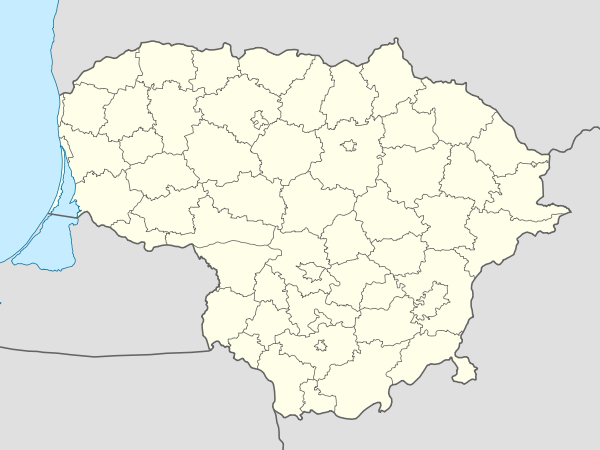Zalavas
| Zalavas | |
|---|---|
| Village | |
|
Street in Zalavas | |
 Zalavas Location of Zalavas | |
| Coordinates: 54°58′N 25°58′E / 54.967°N 25.967°ECoordinates: 54°58′N 25°58′E / 54.967°N 25.967°E | |
| Country |
|
| County | Vilnius County |
| Municipality | Švenčionys district municipality |
| Eldership | Pabradė eldership |
| Population (2001) | |
| • Total | 173 |
| Time zone | EET (UTC+2) |
| • Summer (DST) | EEST (UTC+3) |
Zalavas (Polish: Zułów, Belarusian: Зулаў, Zulaŭ) is a small village in Švenčionys district municipality, Lithuania. It is located on the Mera river near the Lithuanian state border with Belarus. According to the 2001 census, it had 173 residents.[1] It is the birthplace of Marshal Józef Piłsudski, who later became Chief of State of Poland.
Prior to 1939 the village was located in Poland.
History
The village's earliest known name is Mieciany. At some later point, the name was changed, and it became known to its Polish inhabitants as Zułów, and to its Lithuanian ones, as Zalavas. The village was first mentioned in the late 17th century as the private property of Aleksander Wojna-Jasieniecki, a Castellan of Navahrudak. It then passed to the Giedraičiai princely family, and in the 18th century the village was bought by the Rurikid Ogiński family, one of the notable magnate clans of the Grand Duchy of Lithuania. In the early 19th century the village was inherited by the Michałowskis. As part of the dowry of Helena Michałowska, it passed to her husband, Antoni Billewicz, who then bequeathed it to their daughter, Maria Billewiczówna.[2] In 1863, after marrying Józef Wincenty Piłsudski, the village became the property of the Piłsudski family. It was there that both their sons were born, Bronisław Piłsudski, on November 2, 1866, and Józef Piłsudski, on December 5, 1867.
In July 1874, the local manor burned down and the family moved to Vilnius. Soon afterward the family was forced to sell most of their property in Lithuania including Zalavas and nineteen other villages, in order to pay for legal expenses and fines for Bronisław, who was involved in an assassination attempt on the life of tsar Alexander III of Russia. In 1882 the village was bought by Michał Ogiński, an heir to the Ogiński family who had owned it in the 18th century. However, as the policies of Russification of former lands in the Polish–Lithuanian Commonwealth forbade Poles to purchase any real estate, he was forced to sell it to a Russian merchant from Riga named Klim. The latter sold the village to a certain imperial officer named Kuronosov, who divided the property, sold most of the forests and was forced to abandon the area in 1915, during World War I. The Germans occupied the area later that year, and most of the remaining forests were cut down.
In 1920 following the Polish–Lithuanian War, the area became part of the Republic of Central Lithuania. In 1922, after a disputed election, Central Lithuania was annexed by the Second Polish Republic, and Zalavas was incorporated into the Wilno Voivodeship. Since the former Piłsudski's property had belonged to a Russian official who abandoned it, it was nationalized, and limited to the core of 65 hectares, and attached to a military base located nearby. In 1934 an association of veterans of the Polish–Soviet War purchased it from the army and a committee was created whose aim was to rebuild the manor of Marshal Piłsudski, who by then was regarded as a Polish national hero. The manor was reconstructed, and officially opened to the public as a museum on October 10, 1937. However, it was destroyed by the Soviets shortly after the Invasion of Poland in 1939. An oak and a memorial stone still mark the location of the former manor. According to the Soviet–Lithuanian Mutual Assistance Treaty of 1939, Zalavas was returned to Lithuania.
References
- ↑ Vilniaus apskrities kaimo gyvenamosios vietovės ir jų gyventojai (PDF) (in Lithuanian). Vilnius: Department of Statistics to the Government of the Republic of Lithuania. 2003. p. 72. ISBN 9955-588-04-7.
- ↑ Cisek, Janusz (2009-02-04). "Dziecko płci męskiej stanu szlacheckiego". Rzeczpospolita (in Polish). Warsaw. Retrieved 2010-10-23.
External links
- Mieciany (Zułów) in the Geographical Dictionary of the Kingdom of Poland (1885) (Polish)
